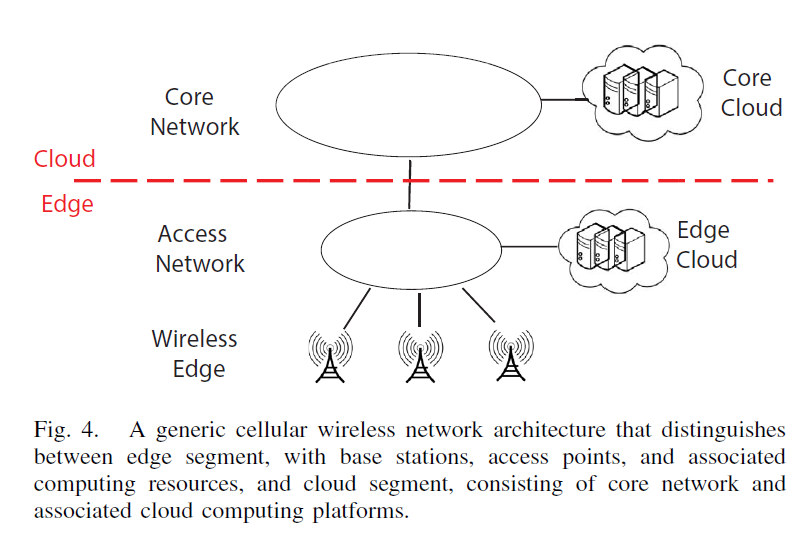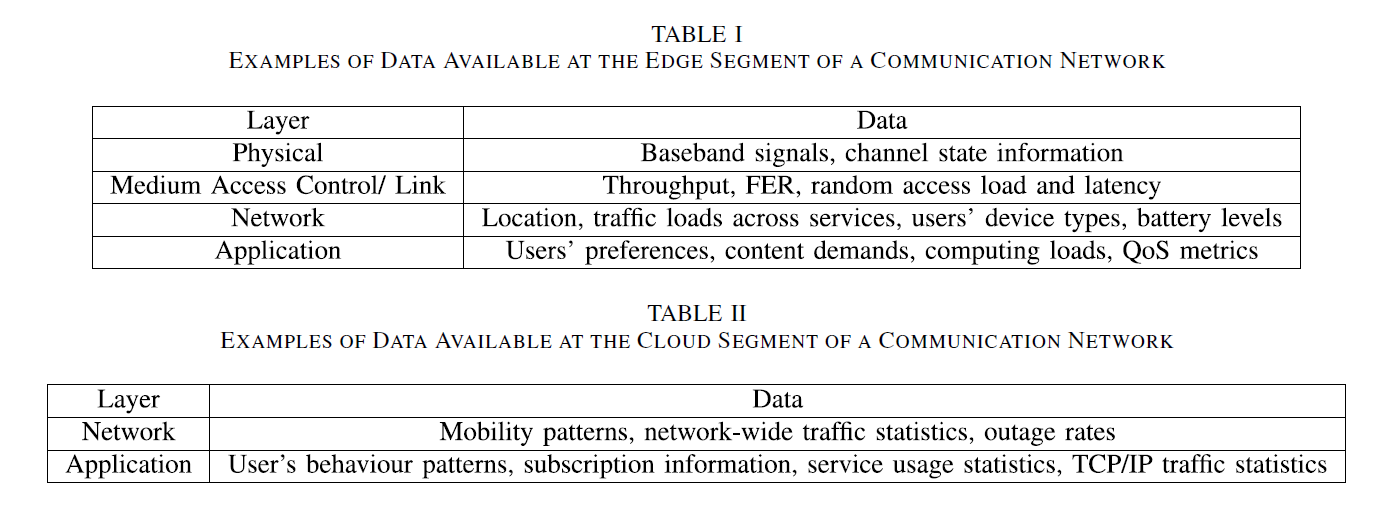Introduction
越读越觉的写的很好,写篇文章给大家分享一下
Main part
In order to exemplify applications of supervised and unsupervised learning, we will offer annotated pointers to the literature on machine learning for communication systems. Rather than striving for a comprehensive, and historically minded, review, the applications and references have been selected with the goal of illustrating key aspects regarding the use of machine learning in engineering problems.
Throughout, we focus on tasks carried out at the network side, rather than at the users, and organize the applications along two axes. On one, with reference to Fig. 4, we distinguish tasks that are carried out at the edge of the network, that is, at the base stations or access points and at the associated computing platforms, from tasks that are instead responsibility of a centralized cloud processor connected to the core network (see [25]). The edge operates on the basis of timely local information collected at different layers of the protocol stack, which may include all layers from the physical up to the application layer. In contrast, the centralized cloud processes longer-term and global information collected from multiple nodes in the edge network, which typically encompasses only the higher layers of the protocol stack, namely networking and application layers. Examples of data that may be available at the cloud and at the edge can be found in Table I and Table II, respectively.
As a preliminary discussion, it is useful to ask which tasks of a communication network, if any, may benefit from machine learning through the lens of the criteria reviewed in Section I-C. First, as seen, there should be either a model deficit or an algorithm deficit that prevents the use of a conventional model-based engineering design. As an example of model deficit, proactive resource allocation that is based on predictions of human behaviour, e.g., for caching popular contents, may not benefit from well-established and reliable models, making a data-driven approach desirable (see [26], [27]). For an instance of algorithm deficit, consider the problem of channel decoding for channels with known and accurate models based on which the maximum likelihood decoder entails an excessive complexity.
Assuming that the problem at hand is characterized by model or algorithm deficits, one should then consider the rest of the criteria discussed in Section I-C. Most are typically satisfied by communication problems. Indeed, for most tasks in communication networks, it is possible to collect or generate training data sets and there is no need to apply common sense or to provide detailed explanations for how a decision was made.
The remaining two criteria need to be checked on a caseby-case basis. First, the phenomenon or function being learned should not change too rapidly over time. For example, designing a channel decoder based on samples obtained from a limited number of realizations of a given propagation channel requires the channel is stationary over a sufficiently long period of time (see [28]).
Second, in the case of a model deficit, the task should have some tolerance for error in the sense of not requiring provable performance guarantees. For instance, the performance of a decoder trained on a channel lacking a well-established channel model, such as a biological communication link, can only be relied upon insofar as one trusts the available data to be representative of the complete set of possible realizations of the problem under study. Alternatively, under an algorithm deficit, a physics-based model, if available, can be possibly used to carry out computer simulations and obtain numerical performance guarantees.
In Sections IV and VI, we will provide some pointers to specific applications to supervised and unsupervised learning, respectively.
为了举例说明监督学习和非监督学习的应用,我们将提供关于通信系统机器学习的文献注释。本文的应用和参考文献并不是为了全面的、历史的回顾而选择的,而是为了阐明机器学习在工程问题中的应用的关键方面。

在整个过程中,我们专注于在网络端而不是在用户端执行的任务,并沿两个轴组织应用程序。 一方面,参考图4,我们将在网络边缘(即,在基站或接入点以及在关联的计算平台上)执行的任务与由集中式任务负责的任务区分开来,即连接到核心网络的云处理器这种任务。
边缘根据协议栈不同层及时收集到的本地信息进行操作,这些协议栈可以包括从物理层到应用层的所有层。
相比之下,集中式云处理从边缘网络的多个节点收集的长期和全局信息,边缘网络通常只包含协议栈的较高层,即网络层和应用层。
表I和表II分别提供了云和边缘可用的数据示例。

作为初步的讨论,通过I-C部分审查的标准,问一下通信网络的哪些任务(如果有的话)可能从机器学习中受益是有用的。
首先,正如所看到的,应该存在模型缺陷或算法缺陷,从而阻止使用传统的基于模型的工程设计。作为模型不足的一个例子,基于对人类行为的预测的主动资源分配,例如,缓存流行的内容,可能不会从完善和可靠的模型中受益,使得数据驱动的方法是可取的(见[26],[27])。对于算法缺陷的一个实例,考虑具有已知和准确模型的信道的信道译码问题,最大似然解码器基于这些模型导致了过度的复杂性。
假设当前问题的特征在于模型或算法不足,则应考虑I-C节中讨论的其余标准。 大多数人通常对沟通问题感到满意。 实际上,对于通信网络中的大多数任务,有可能收集或生成训练数据集,而无需运用常识或为做出决策提供详细的解释。
剩下的两个标准需要逐个检查。首先,要学习的现象或功能不应该随着时间的推移而改变得太快。例如,基于从给定传播通道的有限数量实现中获得的样本设计信道解码器,需要该信道在足够长的时间内保持平稳(见[28])。
其次,在模型不足的情况下,任务应该在不需要可证明的性能保证的情况下对错误有一定的容忍度。 例如,解码器的性能在一个通道缺乏完善的信道模型,如生物通信链路,只能依靠只要一个信托基金的可用的数据代表成套下可能实现问题的研究。或者,在算法不足的情况下,一个基于物理的模型,如果可用,可以用来进行计算机模拟并获得数值性能保证。
reference
O. Simeone, “A Very Brief Introduction to Machine Learning With Applications to Communication Systems,” in IEEE Transactions on Cognitive Communications and Networking, vol. 4, no. 4, pp. 648-664, Dec. 2018, doi: 10.1109/TCCN.2018.2881442.
最后
以上就是机灵夏天最近收集整理的关于Machine Learning for Communication NetworksIntroductionMain partreference的全部内容,更多相关Machine内容请搜索靠谱客的其他文章。








发表评论 取消回复